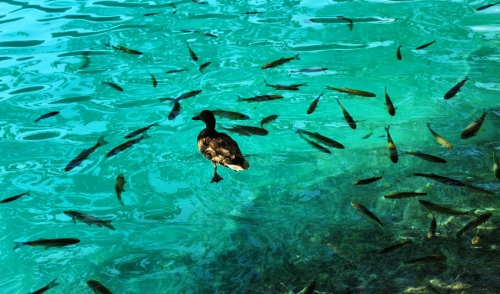{article.name}
Stay Informed
What to Do With Your Fish When Cleaning Your Pond

- Share this:
- Share on Facebook
- Pin on Pinterest
- Tweet on Twitter
Cleaning your pond is essential not only to keep it looking attractive, but also to remove mud, silt, dead leaves and other debris that can unbalance the water chemistry, clog pumps and filters and foster dangerous bacteria. But what should you do with your fish when it is time to give your pond a thorough cleaning?
Why You Need to Remove Your Fish
The most thorough pond cleaning includes draining the water, pressure washing the pond liner, trimming plants, changing filters and possibly rearranging rocks, logs or other items. Any of these tasks can stress and agitate your fish. When fish are uncomfortable or frightened, they may hide, wedging themselves in places where they can become injured or stuck. Terrified fish may even try to jump out of the pond, which can cause injuries or be fatal if you don't notice the escapee right away. Stressed fish are also more vulnerable to illness and extreme stress can cause death. When you plan to clean your pond, it is best to keep your fish in a safe, calm location until they can be moved back into their refreshed home.
A Temporary Home for Your Fish
Any appropriately-sized container can be suitable to hold your fish temporarily while you clean your pond. Easy, effective containers should be at least 12 inches deep and can include…
- Kiddie pools or wading tubs
- A large aquarium tank
- Plastic tub or other watertight container
Rinse the container well, ensuring there are no foreign objects or contaminants that could be harmful to your fish. Position the container in full or partial shade – avoid putting it in full sun, which can become much too warm for fish as the water heats up quickly in the small container. Fill the container with water directly from your pond, which will be most comfortable and least stressful for your fish. The container should also have a mesh or screen cover to keep fish from jumping out and to protect them from harm. If the container does not have a natural cover, a screen door or window screen can be used as a makeshift cover to protect your fish.
Before you move your fish into their temporary accommodations, take steps to make your pond cleaning go more quickly and minimize the time your fish are out of their environment. Assemble all cleaning tools, perform any out-of-the-water tasks such as pruning adjacent plants and skim the surface of the water to remove leaves or other floating debris. The goal is to have your fish out of the pond for as short a time as possible, which will minimize their stress at being disturbed and relocated.
When you are ready to move your fish, drain the pond to 6-8 inches deep to help collect your fish in a smaller area where they will be easier to catch. Use a net to gently catch the fish, quickly transferring them to the temporary container without overly jostling or harming them.
Moving Back In
Once your pond is clean, it may still be some time before you can move your fish back in. The new pond water must be dechlorinated, and it should be given at least an hour or two to warm up slightly to avoid shocking your fish with severe temperature changes. To help balance the new water in your pond, move some of the water from your temporary holding tank into the pond and move some of the new water into the holding tank – this will adjust the temperature as well as the chemical balance, helping your fish acclimate more quickly.
When you are ready to return your fish to their home, you can move them back the same way you transferred them out of the pond, with a net. Another option is to use small buckets for 1-2 fish, suspending those buckets in the pond for 15-30 minutes until the temperature balances, then tipping the buckets gently to let the fish swim out. The key is to always be gentle, and your fish can transition between their home pond and a temporary holding tank with ease.
Special Offers
We are constantly adding new specials to our site. Be sure to check back often!


Comments